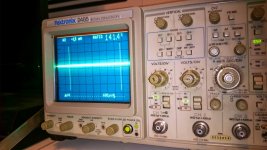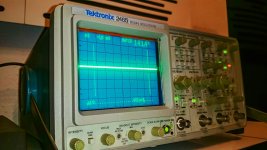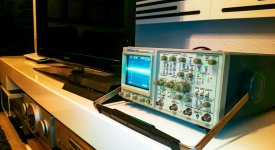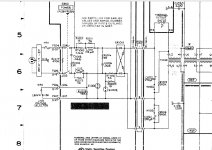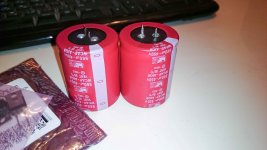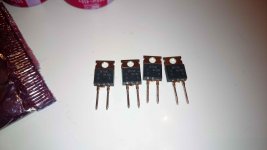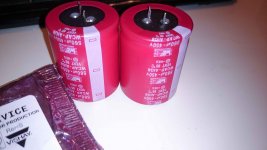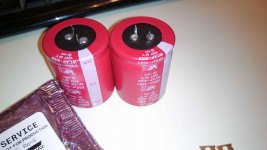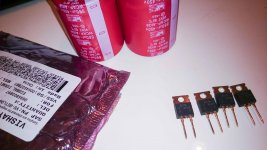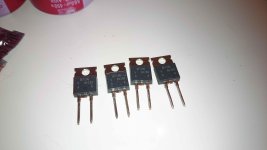Tektronix 2465
A good friend gave me today the best gift I have ever received
Tektronix 2465
4 ch
300mhz
Recommendation on a good Probes
To complete the set ?
A good friend gave me today the best gift I have ever received
Tektronix 2465
4 ch
300mhz
Recommendation on a good Probes
To complete the set ?
Attachments
-
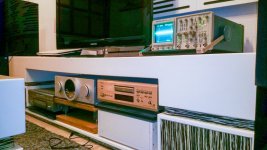 17211883_3553447438131_2002353706626032982_o.jpg309.8 KB · Views: 744
17211883_3553447438131_2002353706626032982_o.jpg309.8 KB · Views: 744 -
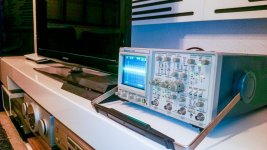 17240495_3553447718138_820573766639661357_o.jpg360.3 KB · Views: 732
17240495_3553447718138_820573766639661357_o.jpg360.3 KB · Views: 732 -
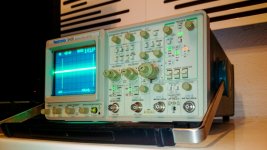 17240666_3553445078072_6550381901784050485_o (1).jpg196.1 KB · Views: 740
17240666_3553445078072_6550381901784050485_o (1).jpg196.1 KB · Views: 740 -
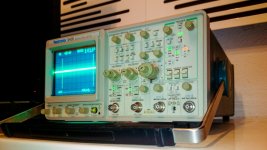 17240666_3553445078072_6550381901784050485_o.jpg196.1 KB · Views: 731
17240666_3553445078072_6550381901784050485_o.jpg196.1 KB · Views: 731 -
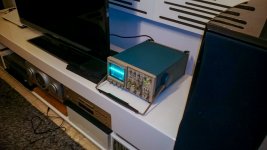 17240675_3553445638086_7783048524509666307_o.jpg193 KB · Views: 676
17240675_3553445638086_7783048524509666307_o.jpg193 KB · Views: 676 -
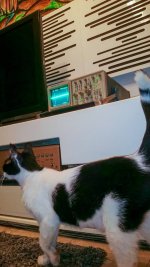 17308925_3553447038121_4373681528108504526_n.jpg69.4 KB · Views: 202
17308925_3553447038121_4373681528108504526_n.jpg69.4 KB · Views: 202 -
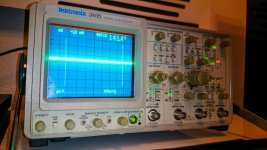 17310138_3553445998095_8647140548798485429_o.jpg289.9 KB · Views: 277
17310138_3553445998095_8647140548798485429_o.jpg289.9 KB · Views: 277
The 2465 is one of the finest analog scopes ever made. I use mine every day.
There is a fellow who specializes in keeping them nimble and fit. You do want to make sure that the battery for the memory gets refreshed. Let me know if you need his email address, although it's a long way from your QTH.
There is a fellow who specializes in keeping them nimble and fit. You do want to make sure that the battery for the memory gets refreshed. Let me know if you need his email address, although it's a long way from your QTH.
After I buy probe
I'll check it in a comprehensive way.
Especially the condition power supply capacitors.
Scope of the new condition.
He was an Israeli high-tech company as a back up scoop.
And almost not used.
I could not believe when I saw his condition
New new new.
It seems as if just out of the box and placed there
I'll check it in a comprehensive way.
Especially the condition power supply capacitors.
Scope of the new condition.
He was an Israeli high-tech company as a back up scoop.
And almost not used.
I could not believe when I saw his condition
New new new.
It seems as if just out of the box and placed there
Congratulations!
I bought several of these for my 2465 and 2445.
I was pleasantly surprised.
Cable Oscilloscope Scope Kit Probe Clip Probes P6200 200MHZ for Tektronix HP | eBay
mlloyd1
I bought several of these for my 2465 and 2445.
I was pleasantly surprised.
Cable Oscilloscope Scope Kit Probe Clip Probes P6200 200MHZ for Tektronix HP | eBay
mlloyd1
My plan as a security measure to check lll the power supply electrolyte capacitors esr
the Smoothing capacitor 290UF
My experience in the past Switching Power Supplies always I up the value without a problem (of course maintaining the voltage required)
i have Capacitors WE 560UF 450V whether it be a problem to replace the original 290uf to 560UF 450v ?
And second question
two safety x film capacitors 68nf
I have currently in stock 100nf X CAP
So does changing the value of 68nf to 100nf possible ?
Best regards david azulay
the Smoothing capacitor 290UF
My experience in the past Switching Power Supplies always I up the value without a problem (of course maintaining the voltage required)
i have Capacitors WE 560UF 450V whether it be a problem to replace the original 290uf to 560UF 450v ?
And second question
two safety x film capacitors 68nf
I have currently in stock 100nf X CAP
So does changing the value of 68nf to 100nf possible ?
Best regards david azulay
Attachments
I remember when we got our Tek 2467B MCP scope in, big $ at the time, we were all in awe. We could see glitch stuff that no other scope could see at that time.
Make sure you get as high as possible ripple current spec'd ecaps. The 560uF would probably have higher ripple current specs than a lower value, but it is ripple current that counts. Do not cheap out on this component.
I would not bother changing the x caps, why?
For probes, I have P6139A that came with the TDS3054B, of course I recommend them over anything else
Make sure you get as high as possible ripple current spec'd ecaps. The 560uF would probably have higher ripple current specs than a lower value, but it is ripple current that counts. Do not cheap out on this component.
I would not bother changing the x caps, why?
For probes, I have P6139A that came with the TDS3054B, of course I recommend them over anything else
Your cap changes should be fine, as long as they fit. As for probes, original Tek with the scale changing input is the best option. Look on ebay for a reasonable price. Another source is a test equipment rental company. You can usually pick up some used probes for a low price from them.
paul
paul
No question that OEM Tek Scope Probes trump (ahem) all others for their scopes ...
if you have the budget or if you get more GREAT gifts

also, if your 2465 hasn't been serviced (i.e. still has original caps) AND if you are up to it, search for some preventative maintenance cap replacements that might need to be done. if i remember to check when i go home, i'll post the link.
better to prevent problems than (try to) fix after it strikes.
mlloyd1
if you have the budget or if you get more GREAT gifts
also, if your 2465 hasn't been serviced (i.e. still has original caps) AND if you are up to it, search for some preventative maintenance cap replacements that might need to be done. if i remember to check when i go home, i'll post the link.
better to prevent problems than (try to) fix after it strikes.
mlloyd1
OK, this is some good reading for owners of this scope:
Tektronix 2465B oscilloscope teardown - Page 1.
Somewhere on this page is a link to this PDF that is really what I wanted to share in my previous post:http://www.condoraudio.com/wp-content/uploads/Projects/Tektronix-2465B-Oscilloscope-Restoration-Repair.pdf. This is another one of interest, but I haven't done anything with this info to my machines: http://worldphaco.com/uploads/TEKTRONIX_2465b_OSCILLOSCOPE_CALIBRATION___REPOWERING_THE_DS1225.pdf
best regards,
mlloyd1
Tektronix 2465B oscilloscope teardown - Page 1.
Somewhere on this page is a link to this PDF that is really what I wanted to share in my previous post:http://www.condoraudio.com/wp-content/uploads/Projects/Tektronix-2465B-Oscilloscope-Restoration-Repair.pdf. This is another one of interest, but I haven't done anything with this info to my machines: http://worldphaco.com/uploads/TEKTRONIX_2465b_OSCILLOSCOPE_CALIBRATION___REPOWERING_THE_DS1225.pdf
best regards,
mlloyd1
first step
I'll change the smoothing capacitor to Wurth Electronics 560 UF -450v -WCAP-AIL8 ( ESR that I measured 0.09 )
(I hope I fit in diameter 42 mm . Length 47 mm )
2) In addition the diodes bridge I'll change to diodes of vishay VS-8ETL06-N3 ultralow forward voltage drop.
3) All electrolytic capacitors in the high voltage area I will try to replace the event that I have in stock
4) Voltage Regulators area I would replace the capacitors to solid polymer capacitors
I'll change the smoothing capacitor to Wurth Electronics 560 UF -450v -WCAP-AIL8 ( ESR that I measured 0.09 )
(I hope I fit in diameter 42 mm . Length 47 mm )
2) In addition the diodes bridge I'll change to diodes of vishay VS-8ETL06-N3 ultralow forward voltage drop.
3) All electrolytic capacitors in the high voltage area I will try to replace the event that I have in stock
4) Voltage Regulators area I would replace the capacitors to solid polymer capacitors
Attachments
Last edited:
Before you do any replacements, sign up and then search the Tektronix group:
https://groups.yahoo.com/neo/groups/TekScopes/info
Most members are very active and many are extremely knowledgable (retired Tektronix folks, etc)., and sometimes, you will get a response from someone who designed the scope you have.
First rule: Get the manual, and then check the power supply voltage levels and ripple. Then check the site listed above and search for known problems for your scope -- especially the tantalum caps (not all were mis-specified, so your scope may be fine).
The SMPS on some Tek scopes sometimes have problems -- usually tantalums that were not rated high enough. You can ruin a scope when replacing electrolytic caps - they can be difficult to get at and desolder, even for experienced people, and some multi-layer boards are fragile (detached traces, vias, etc.).
If the scope has not been used much, the switches may need some cleaning and lubrication.
The Tektronix engineer's usual advice is "don't fix it if it ain't broke". For example, I have a Tektronix 453, built in 1967 or so. It's power supply is still within specs, with original caps (it has a linear supply, so more reliable than SMPS). Despite being full of carbon comp. resistors, the vert. and horiz. amps are within specs-- apparently, the design is robust enough to allow for some drift.
https://groups.yahoo.com/neo/groups/TekScopes/info
Most members are very active and many are extremely knowledgable (retired Tektronix folks, etc)., and sometimes, you will get a response from someone who designed the scope you have.
First rule: Get the manual, and then check the power supply voltage levels and ripple. Then check the site listed above and search for known problems for your scope -- especially the tantalum caps (not all were mis-specified, so your scope may be fine).
The SMPS on some Tek scopes sometimes have problems -- usually tantalums that were not rated high enough. You can ruin a scope when replacing electrolytic caps - they can be difficult to get at and desolder, even for experienced people, and some multi-layer boards are fragile (detached traces, vias, etc.).
If the scope has not been used much, the switches may need some cleaning and lubrication.
The Tektronix engineer's usual advice is "don't fix it if it ain't broke". For example, I have a Tektronix 453, built in 1967 or so. It's power supply is still within specs, with original caps (it has a linear supply, so more reliable than SMPS). Despite being full of carbon comp. resistors, the vert. and horiz. amps are within specs-- apparently, the design is robust enough to allow for some drift.
First thanks for the comment
I joined Yahoo Groups.
As I wrote at first
The device gave me a gift from a good friend who works in a high-tech company.
Oscilloscope hardly worked. He kept them as a backup tool.
Sticker on it was written "not in use"
He knew that a long time I was looking for a scoop like this.
After the company wanted to throw it in the garbage because it is an old model he received permission to give it to me as a gift.
Most of the chances he worked maybe a few hours since it was new.
But as the tires on a vehicle even if the vehicle is not traveling
The tires have wear
So I do not trust the old electrolyte capacitors.
I'll check ESR values of capacitors.
And then decide on a project to make it modern
Or keep it as vintage.
I joined Yahoo Groups.
As I wrote at first
The device gave me a gift from a good friend who works in a high-tech company.
Oscilloscope hardly worked. He kept them as a backup tool.
Sticker on it was written "not in use"
He knew that a long time I was looking for a scoop like this.
After the company wanted to throw it in the garbage because it is an old model he received permission to give it to me as a gift.
Most of the chances he worked maybe a few hours since it was new.
But as the tires on a vehicle even if the vehicle is not traveling
The tires have wear
So I do not trust the old electrolyte capacitors.
I'll check ESR values of capacitors.
And then decide on a project to make it modern
Or keep it as vintage.
When you say "Oscilloscope hardly worked.", do you mean it was hardly used, or it did not function very often? The pictures you posted show what looks like a working scope (readouts are there, the free-running trace looks good).
Of course, there are some documented problems with the 24xx series scopes, but keep in mind that Tek sometimes made changes along the way so it is tricky to generalize.
The article by CondorAudio makes some strange statements (like a 100uF coupling cap has to be exactly 100uF for the voltage to be exactly -8 volts). Anyway, it seems like his scope had many problems and was worth some preventative maintenance while repairing it.
Think twice before blindly replacing parts that may not need replacing, or because someone else replaced them, and know what an acceptable ESR should be, while measuring in-circuit.
If you really want to go through a scope and replace parts and improve it, why not get a non-working one and fix it? Mot of the older Tek scopes (e.g., 400 series) are fun to work on, and the parts are easier to get.
Of course, there are some documented problems with the 24xx series scopes, but keep in mind that Tek sometimes made changes along the way so it is tricky to generalize.
The article by CondorAudio makes some strange statements (like a 100uF coupling cap has to be exactly 100uF for the voltage to be exactly -8 volts). Anyway, it seems like his scope had many problems and was worth some preventative maintenance while repairing it.
Think twice before blindly replacing parts that may not need replacing, or because someone else replaced them, and know what an acceptable ESR should be, while measuring in-circuit.
If you really want to go through a scope and replace parts and improve it, why not get a non-working one and fix it? Mot of the older Tek scopes (e.g., 400 series) are fun to work on, and the parts are easier to get.
When you say "Oscilloscope hardly worked.", do you mean it was hardly used, or it did not function very often? The pictures you posted show what looks like a working scope (readouts are there, the free-running trace looks good).
Of course, there are some documented problems with the 24xx series scopes, but keep in mind that Tek sometimes made changes along the way so it is tricky to generalize.
The article by CondorAudio makes some strange statements (like a 100uF coupling cap has to be exactly 100uF for the voltage to be exactly -8 volts). Anyway, it seems like his scope had many problems and was worth some preventative maintenance while repairing it.
Think twice before blindly replacing parts that may not need replacing, or because someone else replaced them, and know what an acceptable ESR should be, while measuring in-circuit.
If you really want to go through a scope and replace parts and improve it, why not get a non-working one and fix it? Mot of the older Tek scopes (e.g., 400 series) are fun to work on, and the parts are easier to get.
I meant almost never been used in the company.
It was a backup scoop from what my friend said maybe used it for several hours.
This high-tech company worth several hundred million dollars that developed the wireless induction charging.
The equipment they have there. Costs a lot
They wanted to throw him Because they had nothing to do with it .
( It's probably too old equipment for them )
He works no problems.
Last edited:
I would not change any components with different spec devices. And as said above I would only replace components that were bad.
This is a precision test instrument designed by very competent engineers employed by a highly respected electronics company. It's not some audio amp built to a low cost. Altering component values, especially changing diodes to lower voltage drop is asking for trouble.
Sure any circuit can probably be improved upon. But are you going to invest the time to thoroughly analyze the circuit as designed? That means a university knowledge of analog circuit design!
Don't wreck a good scope by throwing typical audiophile voodoo at it, like bigger caps, "better" caps, faster diodes. This is all for naught!
This is a precision test instrument designed by very competent engineers employed by a highly respected electronics company. It's not some audio amp built to a low cost. Altering component values, especially changing diodes to lower voltage drop is asking for trouble.
Sure any circuit can probably be improved upon. But are you going to invest the time to thoroughly analyze the circuit as designed? That means a university knowledge of analog circuit design!
Don't wreck a good scope by throwing typical audiophile voodoo at it, like bigger caps, "better" caps, faster diodes. This is all for naught!
Last edited:
- Status
- This old topic is closed. If you want to reopen this topic, contact a moderator using the "Report Post" button.
- Home
- Design & Build
- Equipment & Tools
- The best gift I have ever received Tektronix 2465
